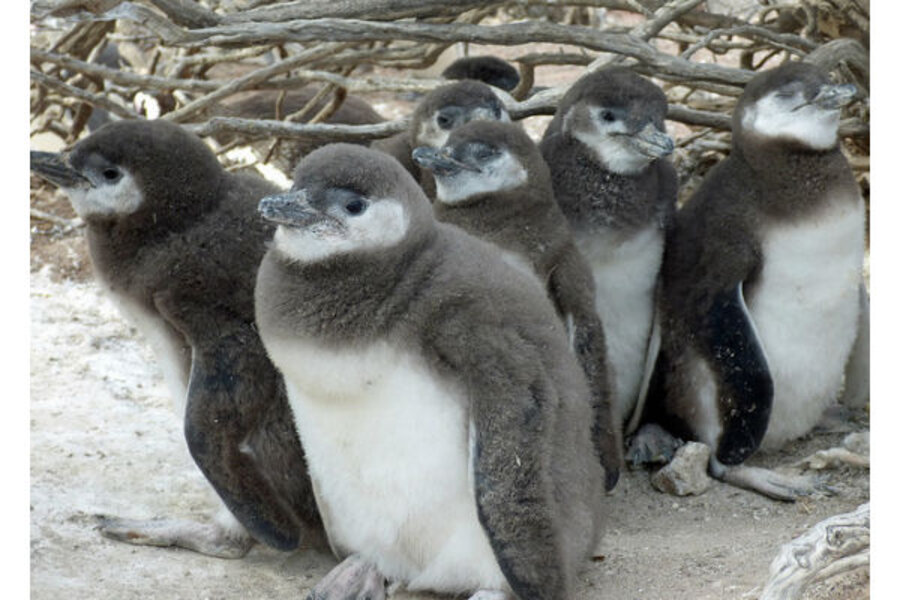Penguins, even in Argentina, at risk from climate change, study says
Loading...
Global climate change is killing chicks in the world’s largest colony of Magellanic penguins, according to a new report, suggesting that the threat is spreading from ice-bound Antarctica to more temperate zones.
In recent decades, extreme weather events have placed unprecedented strain on penguin breeding grounds. Heavy rains and high temperatures put penguin chicks at risk of either freezing or sweltering to death, says P. Dee Boersma, a University of Washington biology professor and director of the Magellanic Penguin Project in Punta Tombo, Argentina.
This news could mean trouble for more than just penguins. Sea birds, mammals, and people are also susceptible to such changes in climate, Dr. Boersma says. She published her findings in the open-access, scientific journal PLOS ONE on Wednesday.
“Penguins are really the ocean’s sentinels,” she says. “They are telling us that we’d better start paying attention to climate change because penguins are dying from heat and these increased storms. At the same time we’re starting to see increased numbers of people die from these same sorts of things. So these penguins are really the canary in the coal mine.”
While scientists have previously sounded the alarm that melting sea ice has depleted penguin populations in Antarctica, including the Emperor penguins made famous by the National Geographic feature film "March of the Penguins," this is one of the first indications that global climate change could also be threatening penguins that reside in more temperate zones.
“The focus has been in Antarctica, but global warming is really impacting almost every single penguin species,” says Dyan de Napoli a penguin expert and former penguin aquarist at Boston’s New England Aquarium. “No matter where they are, every one of the 18 species are being impacted in some way.” Ms. de Napoli was not involved in Boersma’s research in Punta Tombo.
Magellanic penguins, sometimes referred to as Patagonian penguins, are social sea birds native to both the Atlantic and Pacific coastlines of South America. Like many species of penguins, the Magellenic penguins are monogamous, frequently mate for life, and share equally in chick rearing.
Biologists estimate that there are between 1.2 and 1.6 million breeding pairs around the world. The International Union for Conservation of Nature lists the species as “near threatened.”
Until recently, commercial fishing and oil pollution were considered to be the major threats facing these penguins.
“Climate change is really a new factor in terms of mortality for Magellanic penguins,” Boersma says. “It’s really these extreme weather events, which all the climate models predict are going to become more frequent and more extreme, that are killing penguin chicks.”
Boersma has been studying the flightless birds in Punta Tombo for 30 years. In that time, she has seen the both the number and intensity of rain storms increase in the historically arid region. One storm was so intense; it wiped out half of the colony’s chicks.
“Penguins like it dry,” she says, “If they get wet when they are chicks and they are covered in down, it’s like you getting wet in a down sleeping bag. It’s not warm and they die because of hypothermia.”
Excessive heat can be just as problematic for young chicks. While the average temperature for the area has not changed, the range of temperatures has expanded since 1983, with more days reaching into the upper 90s F. Boersma and her team routinely found dead chicks lying prone, with their legs extended in an attempt to cool off in the shade following hot days.
Changes in climate have also impacted the penguins’ food supply. As the climate has shifted, the penguins have been arriving in their breeding grounds later and later. However, many of the fish that they rely on for nourishment are leaving the area at roughly the same time that they did 30 years ago, Boersma says. The result is an increasing shorter breeding season.
Male and female chicks take turns sitting on their eggs and caring for newborn chicks while their mates forage for food. This year, many females were left sitting on eggs for much longer than usual while the males struggled to fill their bellies. In some cases, the males did not return until the eggs had hatched and the females were severely undernourished.
When the females were able to go out it took that much longer for them to replenish their own reserves before they were able to begin to look for food to start feeding the chicks. Newborn chicks can only survive for about seven days on their yolk reserves before they begin to succumb to starvation, Boersma says.
While many penguin species would benefit from fishery conservation and pollution control, it will take a global commitment to carbon reduction in order to address the threats posed by climate change, Boersma and de Napoli say.
“I think that there is a mistaken notion that there are millions and millions and millions of them and I don’t think people are aware of how endangered they are; 14 of the 18 penguin species are listed as threatened, near threatened, or endangered,” de Napoli says. “We’ve seen across the board, with most species, population declines of up to 90 percent in the last century, if not the last 40 years.”








